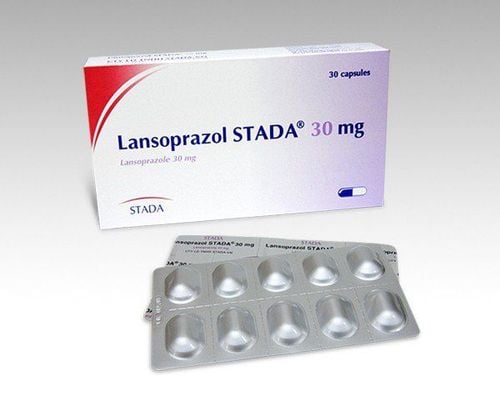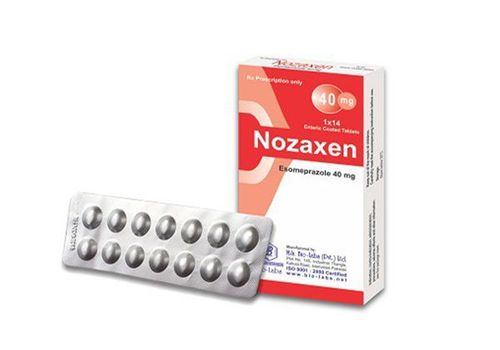This is an automatically translated article.
Lanprasol medicine has the main active ingredient is Lansoprazole with a concentration of 30mg and other excipients in sufficient quantities. The dosage form of the drug is capsule, suitable for direct oral administration. Lanprasol belongs to the group of drugs for the treatment of diseases of the gastrointestinal tract, erosive esophagitis, acute peptic ulcer, Zollinger-Ellison syndrome.
1. What is Lanprasol?
What is Lanprasol? Lanprasol medicine has the main active ingredient is Lansoprazole 30mg and other excipients in sufficient quantity. The dosage form of the drug is capsules, suitable for direct oral use. Packing is a box of 3 blisters or a box of 10 blisters and each blister contains 10 hard capsules. The drug can also be packaged as a box of 14 capsules. Lanprasol belongs to the group of drugs for the treatment of gastrointestinal diseases such as erosive esophagitis, acute peptic ulcer, Zollinger-Ellison syndrome.
1.1. Pharmacodynamics of the active ingredient Lansoprazole Main active ingredient Lansoprazole is a potent inhibitor of acid secretion by inhibiting the enzyme H+,K+ ATPase activity in parietal cells of the gastric mucosa and plays an important role as a proton pump. Clinically, the active ingredient Lansoprazole achieves a fast and high healing rate against gastric ulcer and duodenal ulcer. The usefulness of the drug has been proven. In addition, this drug has also been shown to be effective in the treatment of reflux esophagitis and Zollinger-Ellison syndrome.
1.2. Pharmacokinetics of the active ingredient Lansoprazole Absorption: Lansoprazole is rapidly absorbed from the gastrointestinal tract, but varies depending on dose and gastric pH. Oral bioavailability can be as high as 70% with repeated administration. Distribution: The drug is strongly bound to plasma proteins. Metabolism: The drug is metabolized by the liver. Elimination ability: Active ingredient Lansoprazole is eliminated by the kidneys 80%, the average half-life is about 30-90 minutes. 1.3. The effect of the active ingredient Lansoprazole Active ingredient Lansoprazole inhibits H + / K + - ATPase. The drug causes specific and irreversible inhibition of the proton pump due to its selective effect on gastric parietal cells, so it acts faster and more effectively than other drugs. The rate of scar or ulcer healing can reach 95% after 8 weeks of treatment.
The drug has little effect on gastric juice volume, pepsin secretion, gastric endogenous factor and gastric contractility.
2. What disease does Lanprasol treat?
What are the uses of Lanprasol? This drug is used in the treatment of specific pathologies as follows:Treatment of acute peptic ulcers caused by infection or no infection with H.pylori bacteria. Treatment of erosive esophagitis in patients with gastroesophageal reflux disease. Treatment of specific pathological hypersecretory conditions such as Zollinger-Ellison syndrome, multiple endocrine neoplasia, systemic mastocytosis. Treatment of peptic ulcers caused by the use of non-steroidal anti-inflammatory drugs, also known as NSAIDs.
3. Usage and dosage of Lanprasol
3.1. How to use Lanprasol The drug Lanprasol 30mg is prepared in the form of hard capsules containing Lansoprazole microparticles coated in the intestine, suitable for direct oral use. You should take the pill in the morning before eating, do not break or chew the tablet when using. 3.2. Dosage of the drug Lanprasol Dosage for the treatment of erosive esophagitis due to gastroesophageal reflux disease with adults use 1 tablet / day, for a period of 4 to 8 weeks and can be used for an additional 8 weeks if not. from. Dosage for treatment of peptic ulcer is 1 tablet/day for 4 to 8 weeks. Dosage for treatment of pathological acidosis is 60mg (equivalent to 2 tablets), taken once a day, then adjust the dose according to tolerance and continue treatment until clinical results are achieved. use from 1 to 6 tablets / day (divided into 1-2 times orally) Dosage to treat stomach ulcers while taking NSAIDs is 1 tablet / day, taken for 8 weeks. For people with severe liver failure, the dose should be reduced. The maximum dose is 30 mg/day.
4. Unwanted effects of the drug Lanprasol
During the use of Lanprasol, users of the drug may experience some unwanted reactions to the body, including:
Hypersensitivity reactions: Rash and itching on the skin may occasionally appear. . In this case, the user should stop using the drug containing the main active ingredient, Lansoprazole. For the liver: Caused by an increase in SGOT, SGPT, Phosphatase-alkali, LDH or G-GTP that occurs infrequently, close monitoring is recommended. If abnormalities appear, Lanprasol should be discontinued. For blood: Anemia, decreased white blood cell count, or increased eosinophil count may occur infrequently, thrombocytopenia rarely occurs. For the digestive system: Occasionally, digestive disorders, constipation, diarrhea, dry mouth or abdominal distension may occur. Nervous system: Headache and somnolence may occur infrequently, while insomnia and dizziness are rare. Other undesirable effects such as fever or elevation of total cholesterol and uric acid have occasionally occurred.
5. Lanprasol drug interactions
During the use of Lanprasol may cause interactions with some specific drugs as follows:
Atazanavir: Active ingredient Lansoprazol significantly reduces the absorption of Atazanavir when used simultaneously; Lanprasol should not be used concurrently with Atazanavir. Ketoconazole and Itraconazole drugs: Lanprasol drugs reduce the absorption of Ketoconazole drugs, Itraconazole Digoxin drugs: Lanprasol drugs increase the absorption of Digoxin drugs when used simultaneously, leading to increased plasma concentrations of Digoxin. Therefore, the treating physician needs to adjust the therapeutic dose of Digoxin when starting and ending treatment with Lanprasol. Drugs containing the active ingredient Lansoprazole, in particular Lanprasol, may increase plasma concentrations of drugs metabolised in the liver by the enzyme CYP3A4, and should be used with caution in combination. Warfarin: An increase in prothrombin time and INR has been reported in concomitant use of Warfarin with Lanprasol, which may lead to abnormal bleeding, requiring close monitoring. Tacrolimus: Concomitant use of Lanprasol and Tacrolimus may increase blood levels of Tacrolimus. Sucralfate slows and reduces the absorption of the active ingredient Lansoprazole, so Lanprasol should be taken at least 1 hour after taking this medicine. Concomitant administration of Lanprasol with methotrexate at high therapeutic doses may increase blood concentrations of methotrexate and/or its metabolites, possibly leading to methotrexate toxicity.
6. Some notes when using Lanprasol
6.1. Contraindications of the drug Lanprasol Contraindications of the drug Lanprasol in the following cases:
People with sensitive or sensitive physical conditions to the components of the drug. Patients with malignant peptic ulcer disease. Use caution when using this drug for pregnant and lactating women. 6.2. Warnings and precautions of Lanprasol Use caution when using Lanprasol in children, pregnant women, lactating women, and people with liver failure. During treatment, the treating doctor will assign careful monitoring of the disease status for each specific person. Lanprasol should not be used in maintenance therapy if there is insufficient experience with long-term use. Medicines containing the active ingredient Lansoprazole should be used with caution in people with a history of drug sensitivity, liver dysfunction, and the elderly. Use in children: The safety of Lansoprazole in children has not been established (clinical trials are limited). Use in the elderly: Because the secretion of gastric acid and other physiological functions has decreased in the elderly, Lanprasol should be used with caution. Use in pregnancy and lactation: When experiments were performed on rats, the concentration of lansoprazole in the embryonic serum was higher than in the maternal rat. For rabbits (30mg/kg oral dose) increased embryonic mortality. Therefore, Lanprasol should not be used in pregnant women and women with suspected pregnancy, unless clearly beneficial. Currently, there have been reports in animal studies that the active ingredient Lansoprazole is excreted in human milk. Therefore, the use of Lanprasol in the nursing mother should be avoided. The patient should only use the drug in cases where it is absolutely necessary after the treating doctor has weighed the benefits and possible risks to the health of the baby. At the same time, the mother also needs to stop breastfeeding. Store Lanprasol in a dry place, away from direct light. In addition, it is necessary to keep Lanprasol out of the reach of children and household pets. Never use Lanprasol after its expiry date.
In summary, Lanprasol has the main active ingredient, Lansoprazole, 30mg and other excipients in sufficient quantities. Lanprasol belongs to the group of drugs for the treatment of gastrointestinal diseases such as erosive esophagitis, acute peptic ulcer, Zollinger-Ellison syndrome. When prescribed for use, patients should carefully read the instructions for use, consult a doctor / pharmacist before using the drug. Absolutely do not arbitrarily buy Lanprasol to treat the disease at home, because there may be unwanted side effects on health.
Follow Vinmec International General Hospital website to get more health, nutrition and beauty information to protect the health of yourself and your loved ones in your family.













